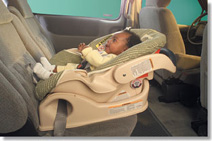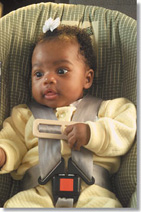In Spanish
In Hmong
In Somali
Installation Checklist 1: Rear-facing Infant-only Car Seat
Important: This is a general checklist designed to be used in combination with your vehicle owner’s manual and your child car seat instruction manual. To get the most out of this checklist, have those manuals handy for quick reference.
___ 1) Check that the car seat is correct for the child's weight and height.- Weight: upper weight limit is 22-40 pounds, depending on the seat; check labels on the car seat for weight limits.
- Height: use only until the baby’s head comes within one inch of the top of the shell; then change to the convertible seat. Check labels on the car seat for height limits.
- The car seat with 5-point harness is preferred.
___ 2) Place the car seat in the back seat of the vehicle.- If the vehicle is an SUV or van with three rows of seats, place the car seat in the middle row.
- Place the car seat in the center of vehicle seat, if possible (see vehicle owner’s manual for details). Note: You may not be able to get a tight fit in the center seat. If that is the case, try to place the car seat in the back seat on the left or right side near a window. The safest way for your baby to ride is in a tightly installed car seat.
- Turn the car seat to face the rear of the vehicle.
___ 3) Select one method only to install the car seat.- Lap belt only (usually found in middle of back seat).
- Lap and shoulder belt
- LATCH system (Lower Anchors and Tethers for Children, built into the vehicle - see below)
Note: Top tethers are not to be used with rear-facing infant seats. Use lower anchors only if attaching with LATCH system.
___ 4) Attach the car seat.
Important: You must check labels on the car seat and the car seat instruction manual for information on how to attach the car seat using either the lap belt, lap and should belt, or LATCH system. Also check your vehicle owner’s manual for instructions, including whether you need to use a locking clip.
This photo shows the rear-facing seat attached with a lap belt only.  - Position the car seat so the baby rides sitting in a semi-reclined position (30-45 degree angle from the vertical – see photo).
___ 5) Tighten the vehicle belt or lower anchor attachment (LATCH).- The car seat must not move more than one inch from side to side or front to back at the point of attachment. Have another person push down firmly on the child car seat while you tighten the vehicle belt, or kneel on the car seat yourself while you tighten the vehicle belt.
___ 6) Buckle the baby into the car seat. - Use the lowest harness slots on the car seat for newborns. Harness straps should be at or below the infant’s shoulders.
- Check that the harness straps are snug and flat on the infant’s shoulders.
- Check that the plastic harness retainer clip is at the infant’s armpit level.
- If using blankets, always buckle the infant in the seat first, then place blankets over the harness.
- Check that the carrying handle is in the proper position. For most infant seats, the carrying handle must be in the "down" position while traveling in a vehicle. However, some seats allow the handle to be in different positions. Check your car seat instruction manual for the right position for your seat.
Source: National Highway Traffic Safety Administration, U.S. Department of Transportation
See how to do it on video: "Your Baby - Newborn to Age 2 in Rear-facing Seats" linked from http://www.chop.edu/carseat
|
|
|
|
|



